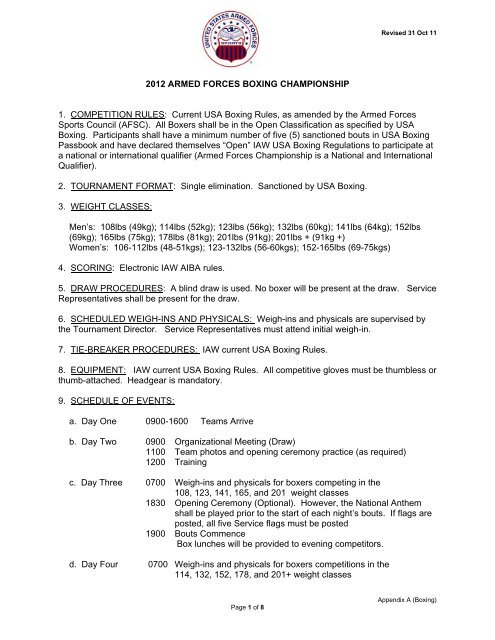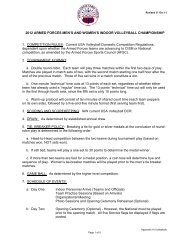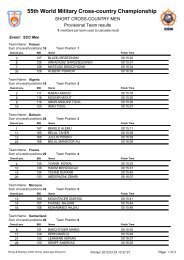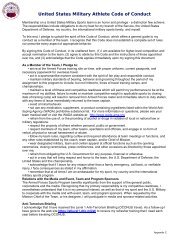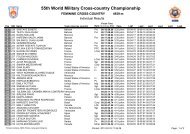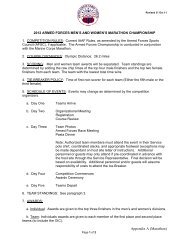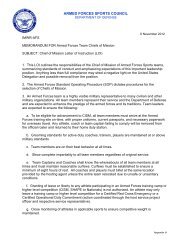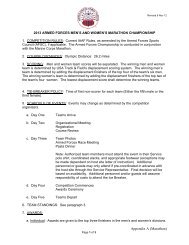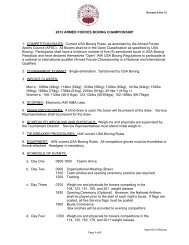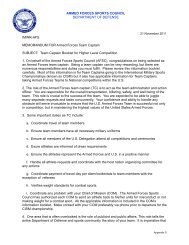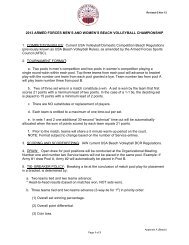Boxing - Armed Forces Sports
Boxing - Armed Forces Sports
Boxing - Armed Forces Sports
Create successful ePaper yourself
Turn your PDF publications into a flip-book with our unique Google optimized e-Paper software.
Revised 31 Oct 11<br />
2012 ARMED FORCES BOXING CHAMPIONSHIP<br />
1. COMPETITION RULES: Current USA <strong>Boxing</strong> Rules, as amended by the <strong>Armed</strong> <strong>Forces</strong><br />
<strong>Sports</strong> Council (AFSC). All Boxers shall be in the Open Classification as specified by USA<br />
<strong>Boxing</strong>. Participants shall have a minimum number of five (5) sanctioned bouts in USA <strong>Boxing</strong><br />
Passbook and have declared themselves “Open” IAW USA <strong>Boxing</strong> Regulations to participate at<br />
a national or international qualifier (<strong>Armed</strong> <strong>Forces</strong> Championship is a National and International<br />
Qualifier).<br />
2. TOURNAMENT FORMAT: Single elimination. Sanctioned by USA <strong>Boxing</strong>.<br />
3. WEIGHT CLASSES:<br />
Men’s: 108lbs (49kg); 114lbs (52kg); 123lbs (56kg); 132lbs (60kg); 141lbs (64kg); 152lbs<br />
(69kg); 165lbs (75kg); 178lbs (81kg); 201lbs (91kg); 201lbs + (91kg +)<br />
Women’s: 106-112lbs (48-51kgs); 123-132lbs (56-60kgs); 152-165lbs (69-75kgs)<br />
4. SCORING: Electronic IAW AIBA rules.<br />
5. DRAW PROCEDURES: A blind draw is used. No boxer will be present at the draw. Service<br />
Representatives shall be present for the draw.<br />
6. SCHEDULED WEIGH-INS AND PHYSICALS: Weigh-ins and physicals are supervised by<br />
the Tournament Director. Service Representatives must attend initial weigh-in.<br />
7. TIE-BREAKER PROCEDURES: IAW current USA <strong>Boxing</strong> Rules.<br />
8. EQUIPMENT: IAW current USA <strong>Boxing</strong> Rules. All competitive gloves must be thumbless or<br />
thumb-attached. Headgear is mandatory.<br />
9. SCHEDULE OF EVENTS:<br />
a. Day One 0900-1600 Teams Arrive<br />
b. Day Two 0900 Organizational Meeting (Draw)<br />
1100 Team photos and opening ceremony practice (as required)<br />
1200 Training<br />
c. Day Three 0700 Weigh-ins and physicals for boxers competing in the<br />
108, 123, 141, 165, and 201 weight classes<br />
1830 Opening Ceremony (Optional). However, the National Anthem<br />
shall be played prior to the start of each night’s bouts. If flags are<br />
posted, all five Service flags must be posted<br />
1900 Bouts Commence<br />
Box lunches will be provided to evening competitors.<br />
d. Day Four 0700 Weigh-ins and physicals for boxers competitions in the<br />
114, 132, 152, 178, and 201+ weight classes<br />
Page 1 of 8<br />
Appendix A (<strong>Boxing</strong>)
2012 ARMED FORCES BOXING CHAMPIONSHIP<br />
1900 Bouts Commence<br />
Box lunches will be provided to evening competitors.<br />
e. Day Five Rest Day<br />
0700 Weigh-ins for all finalists<br />
1730 Informal Ice -Breaker<br />
Note: Authorized team members must attend the event in their<br />
Service polo shirt, coordinated slacks, and appropriate footwear<br />
(exceptions may be made dependant on host site letter of<br />
instruction). Guests may attend with pre-coordination with the<br />
host site and Service representative. Final decision will be based<br />
on availability. Guests will assume costs associated with<br />
attending the ice breaker.<br />
f. Day Six 1900 Bouts Commence (Individual awards presented after each bout)<br />
g. Day Seven Teams Depart<br />
10. TEAM STANDINGS: The following point system will be used to determine team standings<br />
for men’s bouts only:<br />
a. Winner of a finals bout – 2 points<br />
b. Winner of a semifinals bout – 1 point. One (1) point will be awarded regardless of the<br />
method of winning during semifinal bouts (Exception: Bye round winners will receive one (1)<br />
point only if the boxer wins the next bout).<br />
c. In the event of a point tie for the first place team position, the service having the greatest<br />
number of gold medalists, earned through competition in the ring, will be the winner. If a tie still<br />
exists, then the service with the greatest number of silver medalists will determine the position.<br />
No points will be awarded in a weight class where no bout is boxed.<br />
11. AWARDS:<br />
a. Awards shall be given at the conclusion of each championship bout.<br />
b. Individual: Awards are given to the champion and runner-up of each weight class.<br />
c. Team Award: Individuals awards are given to each member of the first place and second<br />
place men’s teams (to include the coaches, team trainer/doctor and OIC).<br />
12. TEAM COMPOSITION - ARMED FORCES CHAMPIONSHIP:<br />
Roster not to exceed 14 individuals:<br />
10 Boxers<br />
1 Coach<br />
1 Asst Coach<br />
1 Certified Trainer/Doctor<br />
1 OIC<br />
Note: Rosters must be submitted NLT four days prior to championship report date.<br />
Page 2 of 8<br />
Appendix A (<strong>Boxing</strong>)
2012 ARMED FORCES BOXING CHAMPIONSHIP<br />
13. TEAM COMPOSITION FOR CISM: As follows or as dictated by host country invitation:<br />
10 Boxers<br />
1 Coach<br />
1 Asst Coach<br />
1 Team Captain<br />
1 Certified Team Trainer/Doctor<br />
1 Chief of Mission<br />
2 Combined <strong>Sports</strong> Committee Members<br />
2 AIBA Referees<br />
TOTAL: 19<br />
14. ATHLETE ADVANCEMENT TO HIGHER LEVEL: A gold medalist advances to higher<br />
level competition. If the gold medalist is not available, the silver medalist advances. If neither<br />
gold nor silver medalist is available, the weight class will not be filled unless the AFSWG votes<br />
on an exception to policy to allow another qualified athlete to substitute. All athletes advancing<br />
to higher level competition should have competed at the <strong>Armed</strong> <strong>Forces</strong> Championship, but can<br />
be considered if the gold or silver medalist is unavailable on a case by case basis. Any Service<br />
boxer awarded a Gold Medal without having boxed at the <strong>Armed</strong> <strong>Forces</strong> Championship, will be<br />
assessed at the Nationals, to ascertain his competitiveness for CISM.<br />
15. COACH SELECTION POLICY: The Head Coach for the <strong>Armed</strong> <strong>Forces</strong> Team will be the<br />
overall winning Head Coach of the <strong>Armed</strong> <strong>Forces</strong> Championship (Subject to review by Service<br />
Representatives at the site of the Championship). The Assistant Coach of the <strong>Armed</strong> <strong>Forces</strong><br />
Team will be the overall second place Head Coach of the <strong>Armed</strong> <strong>Forces</strong> Championship. If the<br />
winning coach is not available, the second place team coach will serve as the Head Coach of<br />
the <strong>Armed</strong> <strong>Forces</strong> Team. Service Reps will vote on the Assistant Coach or for both positions, if<br />
neither the first nor second place coaches are available.<br />
16. FORMS AND ROSTERS:<br />
a. All athletes and coaches shall complete and sign the <strong>Armed</strong> <strong>Forces</strong> <strong>Sports</strong> Higher<br />
Advancement Form for consideration of selection to the <strong>Armed</strong> <strong>Forces</strong> Team. All Higher<br />
Advancement Forms must be submitted by the Officer in Charge of the respective Service at or<br />
before the organizational meeting at the <strong>Armed</strong> <strong>Forces</strong> Championship.<br />
b. All delegation members of the U.S. <strong>Armed</strong> <strong>Forces</strong> Team advancing must sign the<br />
<strong>Armed</strong> <strong>Forces</strong> <strong>Sports</strong> Code of Conduct prior to the start of training camp or departure to higher<br />
level competition if a training camp is not conducted. Team Captains shall hold the signed code<br />
of conduct forms until the conclusion of the championship, or until all related actions of the<br />
championship are finalized.<br />
17. ALCOHOL POLICY: There will be no alcohol consumption at the sports venue by personnel<br />
involved in the <strong>Armed</strong> <strong>Forces</strong> <strong>Sports</strong> competition, including sports staff, until all competition for the<br />
day has been completed to include the award ceremony on the final day. The venue is defined as<br />
the playing area, venue parking lot, and the assigned eating/spectator area. More restrictive<br />
installation policies in regards to alcohol will take precedence.<br />
18. HANDLING OF RULE VIOLATIONS: If there is a violation of the SOP or specific sport rule,<br />
the AFS Representative or in their absence, the project officer, will address the respective<br />
Service Representative to resolve the issue. Service Representative will resolve the violation<br />
before the Service competes in the next game.<br />
Page 3 of 8<br />
Appendix A (<strong>Boxing</strong>)
2012 ARMED FORCES BOXING CHAMPIONSHIP<br />
19. SAFETY, MEDICAL AND HOSTING GUIDELINES:<br />
a. Medical Support:<br />
(1) Ambulance onsite with Advanced Life Support (ALS) equipped paramedics unit.<br />
Basic Life Support (BLS) is NOT sufficient. A volunteer crew will suffice as long as they have all<br />
required ALS Equipment. The unit must be standing by at the facility no matter the proximity of<br />
the local medical facility. Ambulance must be in direct route to a hospital possessing a CT<br />
scanner and neurosurgical capabilities or Medivac contingencies in place to a hospital having<br />
neurosurgical capabilities.<br />
(2) One (or more) medical doctors (MD or Doctor of Osteopathy) with certification by<br />
USA <strong>Boxing</strong> in Ringside Physician techniques who are capable of initiating life-saving<br />
procedures and administering restricted medications. Physician(s) must be in attendance and<br />
seated at ringside at all times during the competition, prepared to deal with any medical<br />
emergency which may arise. Two physicians are preferred, with both at ringside – one always<br />
ready and available to leave the ringside area to attend to any boxer requiring attention.<br />
(3) One additional medical professional such as Certified Athletic Trainer (ATC),<br />
Emergency Medical Technician (EMT), Physician’s Assistant (PA), Physical Therapist (PT), or<br />
physician.<br />
b. Safety precautions and physicians:<br />
(1) Boxers are limited to one bout per day. This restriction applies to military boxers<br />
competing in military, Golden Gloves, Nationals, CISM and all other boxing events.<br />
(2) Physical examinations are mandatory for each competitor on the day they are<br />
scheduled to box. Any boxer complaining of headache symptoms will not be permitted to box in<br />
the subsequent event. Medical officers providing support must be familiar with and meet the<br />
requirements of the Physician’s Ringside Manual. The minimum qualifications of these medical<br />
officers shall include current competency in the emerging treatment of head trauma;<br />
management of traumatic injury; certification in advanced cardio-pulmonary resuscitation; and<br />
experience in the transport of an unstable patient.<br />
(3) A thorough pre-bout physical is required before the draw is conducted, to avoid the<br />
re-drawing of weight categories. Each boxer will also be examined on the day of competition at<br />
weigh-ins and after each bout. The purposes of the pre and post-bout physicals are to<br />
determine the athlete is fit to box on that day, and to determine that the athlete has not suffered<br />
specific injury in the bout. The pre and post-bout physicals are not to be construed as a<br />
“complete annual physical.” The pre and post bout physicals are not meant to determine the<br />
presence of conditions which do not affect the athlete’s ability to compete on the day of<br />
competition. Boxers are subject to disciplinary action should they refuse to be examined after a<br />
bout.<br />
(4) The physician, operating under the Good Samaritan Rule, shall determine if any<br />
injury warrants the match to be discontinued. Upon physician’s decision, said physician shall<br />
advise the boxer and coach/assistant coach, in writing, of treatment for such injury. The<br />
physician is not personally obligated to perform such medical treatment, but must make the<br />
appropriate medical referral for such treatment.<br />
Page 4 of 8<br />
Appendix A (<strong>Boxing</strong>)
2012 ARMED FORCES BOXING CHAMPIONSHIP<br />
(5) In addition to the normal physical examination for all boxers, female boxers shall be<br />
required to furnish, at the time of competition, the normal USA <strong>Boxing</strong> waiver forms in addition<br />
to the following:<br />
(a) A signed explicit disclaimer that the female boxer has read Rule 101.9(4) of the<br />
USA <strong>Boxing</strong> Rules and her physical condition does not, to the best of her knowledge, indicate<br />
the circumstances listed therein. Should any of the circumstances listed in 101.9(4) exist, the<br />
boxer will not be permitted to box.<br />
(b) A waiver that states that to the best of her knowledge, she is not pregnant, nor<br />
does she have surgical breast implants (exception: a female athlete may compete with breast<br />
implants if she has submitted a fully executed “Release to Compete with Breast Implants” form).<br />
(c) At the time of the physical exam, the examining physician will take an<br />
appropriate history of menstruation, pregnancy, breast and gynecological surgery, according to<br />
the recommended sports medical guidelines.<br />
(6) All personnel (competitors, coaches, referees and physicians) are required to attend<br />
at least one pre-competition meeting or clinic. The purpose is to review concepts contained in<br />
the USA <strong>Boxing</strong> Safety Awareness Manual and to explain procedures specific to the event.<br />
Additionally, at this meeting competitors who have little or no experience will be given basic<br />
instructions on the principles of self-defense and the rules of the sport.<br />
(7) In the event of a significant injury or incident during the sanctioned boxing event, an<br />
Incident Report (See attached) shall be completed and forwarded to USA <strong>Boxing</strong>.<br />
(8) In the event of an RSC(H) (Referee Stops Contest due to Head Injury), after<br />
following all USA <strong>Boxing</strong> protocol for rendering immediate care, all forms and Restrictions<br />
Affidavits will be completed and distributed in accordance with USA <strong>Boxing</strong> Rules.<br />
(9) Restriction periods defined.<br />
(a) A restricted boxer shall not be permitted to take part in sparring or competitive<br />
boxing for the duration of the medical restriction. All other training, for conditioning and<br />
maintaining of weight, shall be permitted.<br />
(b) RSC- No restriction period applies. Examples are mismatching (one boxer<br />
clearly outclassed by the other or a boxer who receives excessive body blows) or an injury other<br />
than a head injury which does not require a restriction period.<br />
(c) RSC(H) (30) – 30-day restriction period applies. Examples are: three standingeight<br />
counts in one round or four in a bout due to head blows; a boxer who receives a stunning<br />
head blow and demonstrates a lack of normal response but has not been knocked down, and<br />
has no loss of consciousness; or a boxer who is knocked down from a head blow and<br />
immediately responds normally and assumes the upright, on-guard position, indicating intent to<br />
go on, however, the referee stops the contest.<br />
(d) RSC(H) (90) – 90-day restriction period applies. Examples are: a boxer who has<br />
been knocked unconscious and is unresponsive to normal stimuli for less than two minutes. The<br />
Page 5 of 8<br />
Appendix A (<strong>Boxing</strong>)
2012 ARMED FORCES BOXING CHAMPIONSHIP<br />
ringside physician shall determine the boxer’s unresponsive time by consulting with the official<br />
timekeeper.<br />
(e) RSC(H) (180) – 180-day restriction period applies. Examples are: a boxer who<br />
has been knocked unconscious and is unresponsive to normal stimuli for at least two minutes.<br />
The ringside physician shall determine the boxer’s unresponsive time by consulting with the<br />
official timekeeper.<br />
(f) The same restriction periods as above shall apply to a boxer who has won on<br />
disqualification but was rendered unconscious by illegal blows to the head (head butts, slaps,<br />
elbows, etc.)<br />
(g) RSC(H) (90) or RSC (H) (180) are not arbitrary calls by either the official or<br />
physician. RSC(H) (90) or RSC(H) (180) are defined by the length of time one is unresponsive<br />
or unconscious. The following restriction periods apply when a second RSCH occurs within 90<br />
days after the completion of the restriction period.<br />
period applies.<br />
applies.<br />
applies.<br />
(i) If a second RSC(H) occurs after the initial RSC(H) (30), a 90-day restriction<br />
(ii) If an RSC(H) occurs after an RSC(H) (90), a 180-day restriction period<br />
(iii) If an RSC(H) occurs after another RSC(H) (180), a 365-day restriction period<br />
(h) The terminology KO, KO-H and/or knockout does not apply to amateur boxing.<br />
(i) Before resuming boxing after any of the periods of restriction prescribed in the<br />
preceding paragraphs, a boxer must be given a special examination by the boxer’s personal<br />
physician, who is a qualified doctor of medicine, and certified by the examining physician as fit<br />
to take part in competitive boxing.<br />
(j) Before resuming boxing after any of the periods of restriction prescribed in the<br />
preceding sections, a boxer must, in addition to submitting to the special examination described<br />
above, also have an EEG and/or CT scan at the discretion of the examining physician.<br />
(k) A boxer who loses a bout, which ends in RSC due to body blows, shall not be<br />
subject to a layoff as prescribed under the provision of this rule. However, any boxer suffering<br />
an injury from any cause may not train or compete against the advice of the ringside or<br />
attending physician.<br />
c. Restrictions Affidavit:<br />
(1) For a bout ending in an RSC(H), the injured boxer will be issued a Restrictions<br />
Affidavit with the restriction period as referenced in Section 107.1(13)(d) of the USA <strong>Boxing</strong><br />
Rules. The following individuals must sign the Restrictions Affidavit:<br />
(a) Holder of Sanction<br />
(b) Physician<br />
(c) Referee<br />
Page 6 of 8<br />
Appendix A (<strong>Boxing</strong>)
2012 ARMED FORCES BOXING CHAMPIONSHIP<br />
(d) Boxer’s Coach<br />
(e) Boxer (optional)<br />
(2) The coach who worked the boxer’s corner will be held responsible for accompanying<br />
the boxer to his home or suitable accommodations. Upon their arrival, the coach will present the<br />
Restrictions Affidavit to a responsible adult and then explain its use clearly and thoroughly.<br />
(3) If any of the following symptoms occur, contact a physician immediately.<br />
(a) Headache or dizziness lasting over two hours<br />
(b) Increasing drowsiness or loss of consciousness following the bout (arouse every<br />
two hours during the night following the bout)<br />
(c) Repeated vomiting<br />
(d) Blurred vision<br />
(e) Mental confusion or irrational behavior<br />
(f) Convulsive seizure<br />
(g) Inability to move a limb<br />
(h) Excessive restlessness<br />
(i) Oozing of blood or watery fluid from the ears or nose<br />
(j) Inability to control urine or feces<br />
(4) The release or permission to return to competitive boxing shall be completed on the<br />
reverse side of the Restrictions Affidavit. When signed and approved by the boxer’s personal<br />
physician, who is a qualified doctor of medicine, to return, the Restrictions Affidavit will be<br />
submitted to the LBC (LBC president or registration chairperson) and a copy will be forwarded<br />
to USA <strong>Boxing</strong> Headquarters immediately.<br />
d. Organizer guidance:<br />
(1) <strong>Boxing</strong> competitions are referred to as “<strong>Boxing</strong> Events” or “<strong>Boxing</strong> Show” rather than<br />
“Fights” or “Smoker”. Advertising should promote the healthy spirit of an athletic competition<br />
in the vein of the Olympic status the sport of amateur boxing enjoys. The primary emphasis in<br />
every situation will focus on the safety of the competitors.<br />
(2) Organizers of events involving military boxers are required to retain and be familiar<br />
with the contents of current copies of the USA <strong>Boxing</strong> Rules and regulations, which is the<br />
national governing body for amateur boxing.<br />
(3) Gloves worn will be either thumbless or thumb-attached of a design currently<br />
approved by USA <strong>Boxing</strong>. Glove weight is specified by USA <strong>Boxing</strong>. Headgear must also meet<br />
Page 7 of 8<br />
Appendix A (<strong>Boxing</strong>)
2012 ARMED FORCES BOXING CHAMPIONSHIP<br />
USA <strong>Boxing</strong> specifications and will be worn by boxers regardless if competition on base or in<br />
civilian venues and including all sparring sessions. Month pieces must be custom made and<br />
individually fitted. Groin protectors must meet USA <strong>Boxing</strong> specifications and must be worn at<br />
all times during competition and sparring. The breast protector (for women boxers) must be well<br />
fitted and not interfere with the boxer’s ability to box.<br />
(4) All <strong>Armed</strong> <strong>Forces</strong> Championships shall be properly sanctioned by USA <strong>Boxing</strong>.<br />
Page 8 of 8<br />
Appendix A (<strong>Boxing</strong>)


